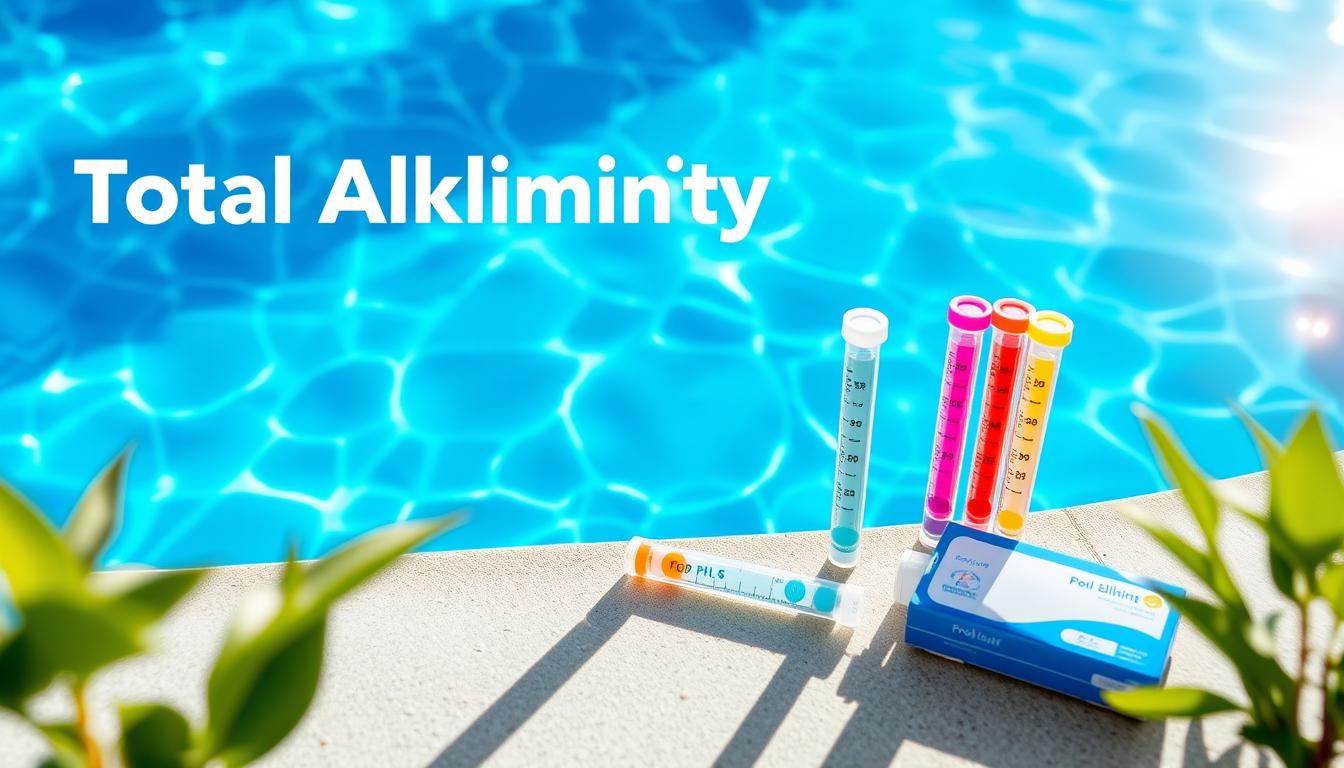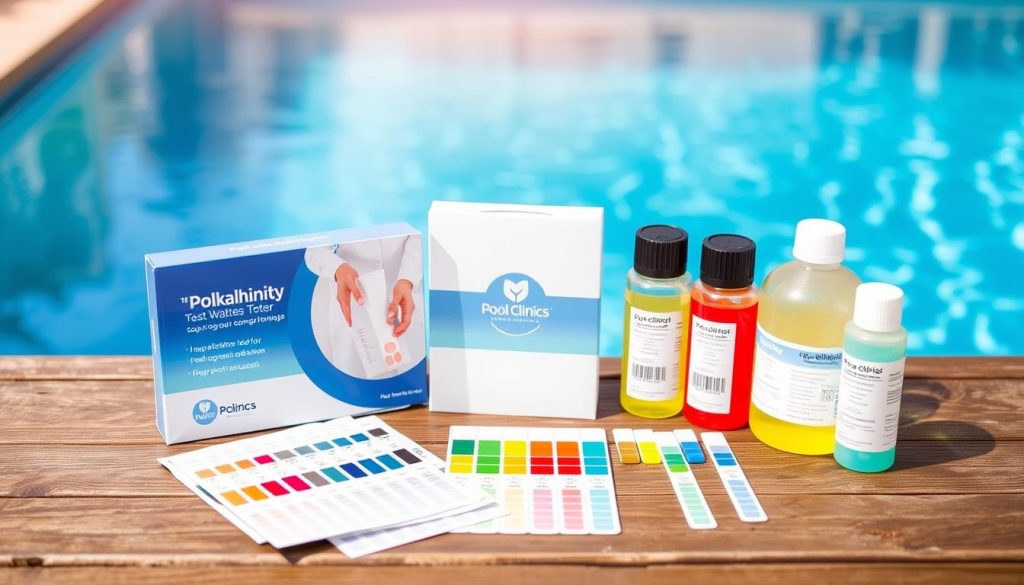
Balanced pool water chemistry is crucial for a safe and enjoyable swimming experience. Total alkalinity is a key factor in maintaining this balance. It’s often overlooked but essential for keeping pools clean and clear.
This article explores total alkalinity’s role in pool maintenance. We’ll discuss its importance and how to keep your pool in top condition.
Total alkalinity measures alkaline substances in pool water, mainly bicarbonates. These act as a buffer for pH levels. The right alkalinity balance prevents sudden pH changes.
It creates a stable environment for pool water minerals. This stability ensures water clarity and swimmer comfort. It also promotes effective sanitization and protects pool equipment.
Key Takeaways:
- Total alkalinity is a critical component of balanced pool water chemistry.
- Proper alkalinity levels help prevent sudden pH changes and maintain water clarity.
- The recommended range for total alkalinity in swimming pools is between 80 and 120 parts per million.
- Low alkalinity can lead to chlorine inefficiency, metal corrosion, pool staining, and scale formation.
- High alkalinity can cause cloudy water, reduced circulation, clogged filters, and rough surfaces.
Understanding Total Alkalinity in Pools
Pool owners must grasp total alkalinity’s role in maintaining a balanced swimming environment. It measures the water’s ability to resist pH changes. Total alkalinity acts as a buffer to prevent drastic pH fluctuations.
While it doesn’t directly determine pH, it keeps pH levels stable. Regular monitoring ensures a safe and enjoyable swimming experience for all.

Definition of Total Alkalinity
Total alkalinity is the concentration of alkaline substances in pool water. These include carbonates, bicarbonates, and hydroxides. They work together to neutralize acids and maintain stable pH levels.
The ideal alkalinity range is 80 to 120 parts per million (ppm). However, 50 to 90 ppm is acceptable if pH remains consistent.
Importance of Maintaining Proper Alkalinity Levels
Proper alkalinity levels are crucial for several reasons:
- It prevents rapid pH swings, which can cause skin and eye irritation for swimmers.
- It ensures the effectiveness of pool sanitizers, such as chlorine, by providing a stable environment for them to work in.
- It helps protect pool equipment and surfaces from corrosion and scaling caused by imbalanced water chemistry.
According to pool industry experts, testing alkalinity levels in pool water should be done at least once a week for optimal maintenance.
Ideal Range for Total Alkalinity in Pools
The recommended total alkalinity level for pools is between 80 to 120 ppm. This range allows for effective pH buffering. It prevents the water from becoming too acidic or alkaline.
Maintaining ideal alkalinity helps keep pool chemical levels balanced. This ensures a safe and comfortable swimming experience for everyone.
| Alkalinity Range (ppm) | Effect on Pool Water |
|---|---|
| Below 80 | Rapid pH fluctuations, corrosion of equipment, irritation to swimmers |
| 80-120 (Ideal) | Stable pH levels, effective sanitization, comfortable swimming |
| Above 120 | Difficulty adjusting pH, cloudy water, scaling on surfaces |
Regular testing and adjusting of alkalinity levels is essential. Use alkalinity test kits and appropriate pool chemicals like baking soda or muriatic acid.
This helps maintain proper pH levels and ensures a well-balanced swimming environment. For complex adjustments, consider seeking professional help.
Consequences of Imbalanced Total Alkalinity
Proper total alkalinity levels are vital for a safe and enjoyable pool experience. Imbalanced alkalinity can harm water quality and pool equipment. Let’s explore the effects of low and high alkalinity in pools.
Low Alkalinity: pH Bounce and Other Issues
Low alkalinity, below 80 ppm, can cause pH bounce. This makes pH levels unstable and hard to control. It can lead to acidic water, irritating swimmers’ eyes and skin.
Acidic water can corrode pool equipment and surfaces. It may also cause green or brown stains on pool walls and floors. Low alkalinity can promote algae growth, resulting in green water.
High Alkalinity: Difficulty Adjusting pH and Scaling Problems
High alkalinity, above 120 ppm, creates different challenges. It makes pH adjustment difficult, as water resists change. This can lead to consistently high pH levels.
High pH can cause scaling on pool surfaces and equipment. Scaling forms when minerals precipitate out of water. It can reduce circulation, clog filters, and cloud water.
High alkalinity also reduces sanitizer effectiveness. This makes it harder to maintain a clean, healthy swimming environment.
| Consequence | Low Alkalinity ( | High Alkalinity (> 120 ppm) |
|---|---|---|
| pH Stability | pH bounce, difficult to maintain | Resistant to pH changes |
| Swimmer Comfort | Eye and skin irritation | Eye and skin irritation |
| Pool Surfaces | Staining, etching | Scaling, cloudy water |
| Equipment | Corrosion | Reduced circulation, plugged filters |
| Sanitizer Effectiveness | Reduced | Reduced |
Both low and high alkalinity can seriously affect your pool. Regular testing and balancing are crucial to avoid these issues. Keep total alkalinity between 80-120 ppm for a safe, comfortable, and appealing swimming environment.
What is Total Alkalinity in a Pool and How to Test It
Total alkalinity measures alkaline substances in pool water. These include carbonates, bicarbonates, and hydroxides. They act as buffers, stabilizing pH levels and preventing rapid changes.
Regular testing keeps alkalinity within 80-120 ppm. Use a reliable test kit like the Liberty Gold Standard Pool and Spa Water Testing Kit. Test at least weekly to avoid cloudy water, algae growth, and equipment corrosion.
Step-by-Step Guide to Testing Total Alkalinity
Collect a water sample 18 inches below the surface. Add reagents as directed by your test kit. Count the drops needed to change the water’s color.
The number of drops added shows the total alkalinity level. This simple process helps maintain a balanced pool environment.
Recommended Frequency of Testing
Test your pool’s total alkalinity weekly for a balanced environment. More frequent testing may be needed if water quality issues arise.
To lower high alkalinity, add muriatic acid or dry acid in small amounts. For low levels, add baking soda at 1.4 lbs per 10,000 gallons.
Regular monitoring ensures a clean, safe, and comfortable swimming experience. Adjust alkalinity levels as needed for optimal pool maintenance.







